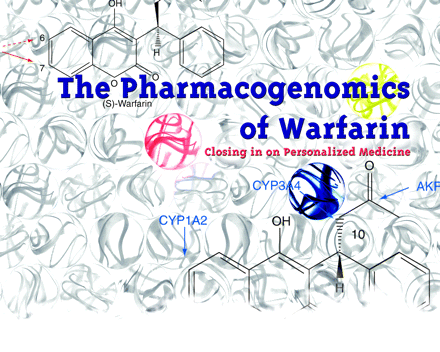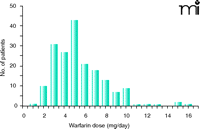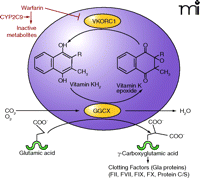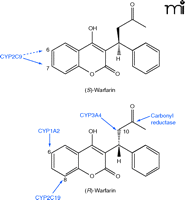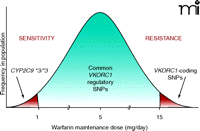The Pharmocogenomics of Warfarin
Closing in on Personalized Medicine
Abstract
Warfarin, a coumarin anticoagulant, is used worldwide for the treatment and prevention of thromboembolic disease. Warfarin therapy, however, can be difficult to manage because of the drug’s narrow therapeutic index and the wide interindividual variability in patient response. It is now clear that genetic polymorphisms in genes influencing metabolism (CYP2C9) and pharmacodynamic response (VKORC1) are strongly associated with warfarin responsiveness. Optimal warfarin dosing in turn drives other positive anticoagulation–related outcomes. Therefore, a strong basic science argument is emerging for prospective genotyping of warfarin patients. Effective clinical translation would establish warfarin pharmacogenomics as a heuristic model for personalized medicine.
Introduction
The oral anticoagulant drug warfarin was first synthesized in 1948 in Karl Link’s laboratory in Wisconsin as part of a program to develop more potent rodenticides based on the structure of dicoumarol, which Link had identified as the hemorrhagic component of sweet clover disease (1). Warfarin (Coumadin) was introduced into clinical practice in the 1950s, and by the new millennium it was a Top 20 drug in the United States, and the most widely used world-wide for the oral treatment and prevention of thromboembolic events, including atrial fibrillation and deep-vein thrombosis (2).
Although interindividual variability in drug response plagues treatment with many classes of therapeutic agent (3), this scenario is particularly pointed for warfarin. In any given patient population the daily therapeutic warfarin dose will vary by more than an order of magnitude (Figure 1⇓). This situation is made more dramatic for warfarin because, in general, patients are all titrated to the same pharmacological endpoint—a two- to threefold increase in their clotting (prothrombin) time. The time to stable dosing with warfarin can be many months, and thus patients can be at risk of excessive bleeding if the initiating doses are too high, or ineffective clot control if the doses are too low.
Interindividual variability in warfarin dose. Histogram of warfarin maintenance dose in 185 patients of European descent attending antiocoagulation clinics in Seattle.
It is estimated that non-genetic factors such as age, gender, body mass index, and drug history contribute up to 30% to warfarin dose variability (4), and these readily accessible clinical characteristics are generally taken into account when prescribing initial doses of the drug. Pharmacogenomic studies of responsiveness to warfarin seek to identify genetic factors impinging on warfarin dose variability and thereby enhance patient treatment. Recent progress in the identification of genes that influence the pharmacokinetics and pharmacodynamics of the drug makes the idea of “personalized medicine” for warfarin increasingly attractive, form the basis of this review.
Mechanism of Action
Warfarin, like other 4-hydroxycoumarin derivatives used as oral anticoagulants, acts as a vitamin K antagonist by inhibiting the regeneration of reduced vitamin K, an essential cofactor for the clotting cascade (Figure 2⇓). The target enzyme for warfarin, vitamin K epoxide reductase complex 1 (VKORC1), catalyzes the rate-limiting step in the vitamin K cycle (5), and is inhibited non-competitively by coumarin anticoagulants (6). Although extensively characterized in crude tissue extracts, the VKORC1 enzyme was never successfully purified, perhaps because it forms part of a larger, oligomeric protein complex. Indeed, the VKORC1 gene was not identified until 2004 (7, 8). This recent discovery has prompted intensive investigation into the role that genetic variation in VKORC1 plays in oral anticoagulant drug response.
Mechanism of action of warfarin and roles of CYP2C9 and VKORC1 in modulating anticoagulation. Warfarin exerts its pharmacological effect by inhibiting VKORC1. VKORC1 is the vitamin K cycle enzyme controlling regeneration of reduced vitamin K, an essential cofactor that drives formation of the clotting factors. CYP2C9 is the major P450 enzyme that metabolizes S-warfarin to inactive metabolites. CYP2C9, Cytochrome P4502C9; VKORC1, vitamin K epoxide reductase complex 1, GGCX, gamma-glutamyl carboxylase. Adapted from (31).
VKORC1 Genetics
The gene for human VKORC1, which maps to the short arm of chromosome 16, contains three exons coding for an 18-kDa, integral membrane protein. VKORC1 coding region mutations in homozygous patients cause multiple coagulation factor deficiency type 2, whereas warfarin resistance appears in heterozygotes (8). Several groups have now identified patients with varying degrees of warfarin resistance who carry mutations in one copy of the gene that encodes vitamin K epoxide reductase complex 1 (VKORC1) (Table 1⇓). Given the small numbers of resistant patients examined to date, the assignments made in the Table as to the severity of phenotypes should be viewed tentatively. It is also worth noting that not all subjects requiring very high maintenance doses of warfarin carry mis-sense mutations in VKORC1; other factors, including non-compliance, accelerated metabolism, and excessive dietary vitamin K, may contribute to a resistance phenotype independent of VKORC1 status. Further studies are required to clarify the mechanism underlying warfarin resistance secondary to structural alterations in the VKORC1 protein.
Non-Synonymous Mutations in VKORC1 Leading to Warfarin Resistance
The mis-sense mutations described above are all rare polymorphisms (allele frequency <<0.1%) and account for very little of the population variability observed with regard to warfarin response. In contrast, it is now well established that common polymorphisms in regulatory regions of the VKORC1 gene correlate strongly with warfarin response across the normal dosing range. Rieder and colleagues have re-sequenced the entire VKORC1 gene in almost 200 European-American warfarin patients and have identified five haplotypes, typified by non-coding polymorphisms, that associate significantly with warfarin dose requirements (9). Haplotypes H1 and H2 (group A) segregate with a low-dose warfarin phenotype (mean ~3 mg/day), whereas, haplotypes H7–H9 (group B) segregate with a high-dose phenotype (mean ~ 7 mg/day). A single allelic site, 1173T/C in intron 1, assigns European-American subjects to either the A or B groups ~95% of the time. This highly useful single nucleotide polymorphism SNP has been shown repeatedly to associate with optimal coumarin anticoagulant dose in both European and Asian patients (10–13). Indeed, the well-recognized reduction in average maintenance dose of warfarin for Asian patients is largely a consequence of the paucity of the high-dose associated 1173T allele (B group) in this ethnic population (14). In Caucasian and Asian populations, VKORC1 genotype predicts 25% of the variability in warfarin dose.
Mechanism of Warfarin Elimination: Role ofCYP2C9
The termination of warfarin’s pharmacological effect depends on hepatic metabolism, catalyzed largely by the cytochrome P450 (CYP) system. The administered drug is a racemic mixture of S and R enantiomers, with the S enantiomer accounting for the majority of the therapeutic effect. Whereas R-warfarin utilizes several metabolic clearance pathways (Figure 3⇓), S-warfarin at therapeutic concentrations is metabolized predominantly by CYP2C9, which converts the drug to inactive 7-hydroxy and 6-hydroxy metabolites that are excreted in the urine (15). Consequently, it would be expected that variation in the CYP2C9 gene might contribute to interindividual variability in warfarin response.
Variants ofCYP2C9
The CYP2C9 gene maps to chromosome 10q24.2, contains 9 exons, and codes for a 60-kDa microsomal protein. Semi-systematic SNP discovery has been carried out in a variety of ethnic populations, and thirty CYP2C9 alleles that pertain to coding regions have been reported [see the P450 Allele Web Site (http://www.imm.ki.se/CYPalleles/cyp2c9.htm)]. Among these multiple alleles, CYP2C9*1 represents the reference sequence and wild-type allele. The CYP2C9*2 and CYP2C9*3 alleles encode the Arg144Cys and Ile359Leu variants and are present at allele frequencies of ~12% and ~8%, respectively, in Caucasians (16). Approximately 40% of this population thus express one or both of the variant enzymes. In vitro, reconstituted recombinant CYP2C9*2 and CYP2C9*3 are functionally defective, exhibiting only ~70% and ~5% metabolic efficiency, respectively, relative to the wild-type enzyme in turning over S-warfarin (17). Consequently, it would be anticipated that carriers of these two alleles would metabolize S-warfarin more slowly in vivo and, therefore, require lower maintenance doses of the drug. Indeed, a graded reduction in warfarin dose requirement for carriers of the CYP2C9*2 and CYP2C9*3 alleles has been demonstrated by multiple research groups (18), and these alleles are considered strong risk factors for over-anticoagulation if patients are initiated with “standard” doses of warfarin that are, in effect, more appropriate for CYP2C9*1 homozygotes.
In other ethnic groups, the prevalence and pattern of CYP2C9 alleles differ considerably from the situation in Caucasians. In black patients, for example, CYP2C9*2 and CYP2C9*3 occur at much lower allele frequencies (1–3%) than in white patients (19). Two novel alleles, CYP2C9*5 and CYP2C9*6, are selectively expressed in subjects of African descent, and there is in vivo evidence that these are functionally defective, although both occur rarely (< 1% frequency) (20, 21). East Asians completely lack the CYP2C9*2 allele, and the CYP2C9*3 allele is present at only 1–3% in Chinese, Korean, and Japanese populations (19). In these populations, the novel defective alleles CYP2C9*4 (22), CYP2C9*13 (23), and CYP2C9*25, *26, *28, and *30 (24) have been found, but again frequencies are low (<1%). In vivo studies support a functional deficit for CYP2C9*4 and *13, but only in vitro data are currently available for the latter four alleles (see Table 2). More extensive studies are needed to fully define the complement of functionally defective CYP2C9 alleles in different ethnic groups, in part so that we can determine which populations might most benefit from CYP2C9 genotyping (25). In extensively studied Caucasian populations, CYP2C9 genotype predicts ~10% of the variability in warfarin dose.
Association ofCYP2C9andVKORC1 Polymorphisms with Other Anticoagulation Parameters
The vast majority of pharmacogenomic studies involving warfarin have used dose as the primary endpoint for analysis; however, a variety of other outcomes may have more direct clinical significance. Severe and potentially fatal hemorrhaging, in particular, is the single most serious adverse effect associated with warfarin therapy, and clear evidence that genotyping limits this risk would provide a persuasive argument for routine adoption of pharmacogenomic testing in the clinical setting. However, because the incidence of severe bleeds is (thankfully) low, large populations need to be evaluated in order to present a strong statistical argument.
A meta-analysis of nine studies involving almost 3000 warfarin patients indicates that carriers of the CYP2C9*2 and *3 alleles are at a significantly higher risk of bleeding (26). Similarly, in a study of almost 1000 patients treated with acenocoumarol, a warfarin analog that also relies on CYP2C9 for its metabolic clearance, the hazard ratio for a major bleeding event was significantly higher in carriers of the CYP2C9*2 and *3 alleles (27). Evidence that VKORC1 genotype is associated with bleeding risk in patients treated with coumarin anticoagulants is less clear (28), but no large-scale studies have yet been reported.
Summary and Conclusions
Figure 4⇓ summarizes known genetic liabilities regarding warfarin dosing for Caucasian subjects, the most extensively studied patient group. Whereas coding-region polymorphisms in VKORC1 can lead to varying degrees of warfarin resistance, coding-region polymorphisms in CYP2C9 are associated with enhanced sensitivity to the drug, necessitating low doses, especially in the case of CYP2C9*3 homozygotes. Polymorphisms in non-coding regions of VKORC1 contribute substantially to warfarin dose variability across the “normal” dose range. By combining patient clinical characteristics with knowledge of CYP2C9 and VKORC1 genotypes, as much as 60% of the variability in warfarin dose requirements can be explained. These advances have fueled speculation that the Food and Drug Administration might implement a change in the labeling of warfarin to require pharmacogenomic testing during the initiation phase of treatment. In November 2005, the FDA’s Clinical Pharmacology Subcommittee met to discuss questions related to the genotyping of warfarin patients (see www.thepinksheet.com/FDC/AdvisoryCommittee/Committees/Pharmaceutical+Scienc/111405_clinpharm1/1114-1505_ClinPharmP.htm), but a “pharmacogenomic sea-change” probably awaits the results from prospective, randomized clinical trials. In the interim, other priority endeavors include the search for new candidate genes that can better inform warfarin dosing decisions, and exploration of the consequences of genetic variation in CYP2C9 and VKORC1 in minority populations.
Genetic liabilities for warfarin sensitivity and resistance. Coding-region mutations in the VKORC1 gene can cause warfarin resistance that necessitates daily doses in excess of 15 mg/day (see also Table 1). Conversely, mutations in the CYP2C9 gene, especially homozygosity for the CYP2C9*3 allele, can result in sensitivity to the drug such that doses less than 1 mg/day are sufficient to achieve therapeutic anticoagulation. Non-coding region polymorphisms in VKORC1 also influence warfarin dose across the “normal” dosing range.
Acknowledgments
We acknowledge NIH grants GM068797 and NS053646 for financial support. We are also indebted to Drs. Mark J. Rieder and David L. Veenstra (University of Washington) who collaborated on several of the pharmacogenetic studies discussed in this review.
- © American Society for Pharmacology and Experimental Theraputics 2006
References

Guoying Tai, PhD, recently earned her doctoral degree, having worked in Allan Rettie’s laboratory. Her research focused on the pharmacogenetics and structure-function relationships of CYP2C9.

Allan E. Rettie, PhD, is Professor and Chairman of the Department of Medicinal Chemistry at the University of Washington in Seattle. Trained in drug metabolism, his interests pertain to the enzymology and pharmacogenetics of oxidative drug metabolism. Address correspondence to AER. E-mail rettie{at}u.washington.edu; fax 206-685-3252.

